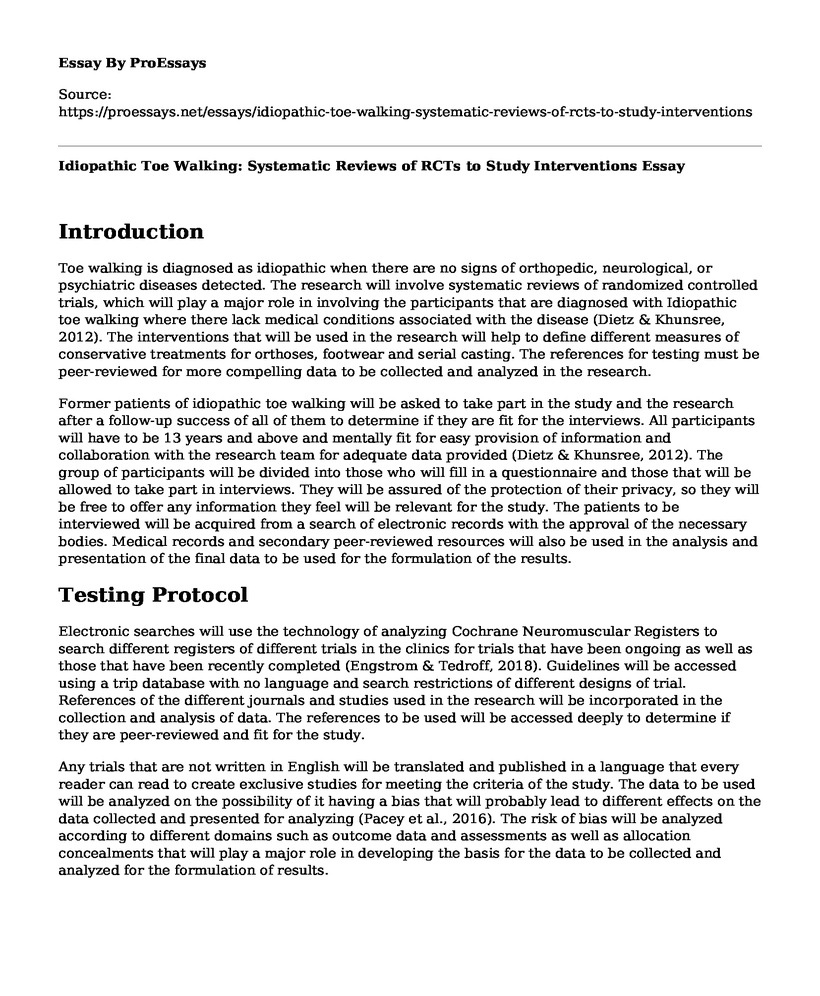Introduction
Toe walking is diagnosed as idiopathic when there are no signs of orthopedic, neurological, or psychiatric diseases detected. The research will involve systematic reviews of randomized controlled trials, which will play a major role in involving the participants that are diagnosed with Idiopathic toe walking where there lack medical conditions associated with the disease (Dietz & Khunsree, 2012). The interventions that will be used in the research will help to define different measures of conservative treatments for orthoses, footwear and serial casting. The references for testing must be peer-reviewed for more compelling data to be collected and analyzed in the research.
Former patients of idiopathic toe walking will be asked to take part in the study and the research after a follow-up success of all of them to determine if they are fit for the interviews. All participants will have to be 13 years and above and mentally fit for easy provision of information and collaboration with the research team for adequate data provided (Dietz & Khunsree, 2012). The group of participants will be divided into those who will fill in a questionnaire and those that will be allowed to take part in interviews. They will be assured of the protection of their privacy, so they will be free to offer any information they feel will be relevant for the study. The patients to be interviewed will be acquired from a search of electronic records with the approval of the necessary bodies. Medical records and secondary peer-reviewed resources will also be used in the analysis and presentation of the final data to be used for the formulation of the results.
Testing Protocol
Electronic searches will use the technology of analyzing Cochrane Neuromuscular Registers to search different registers of different trials in the clinics for trials that have been ongoing as well as those that have been recently completed (Engstrom & Tedroff, 2018). Guidelines will be accessed using a trip database with no language and search restrictions of different designs of trial. References of the different journals and studies used in the research will be incorporated in the collection and analysis of data. The references to be used will be accessed deeply to determine if they are peer-reviewed and fit for the study.
Any trials that are not written in English will be translated and published in a language that every reader can read to create exclusive studies for meeting the criteria of the study. The data to be used will be analyzed on the possibility of it having a bias that will probably lead to different effects on the data collected and presented for analyzing (Pacey et al., 2016). The risk of bias will be analyzed according to different domains such as outcome data and assessments as well as allocation concealments that will play a major role in developing the basis for the data to be collected and analyzed for the formulation of results.
Data Analysis
All data that will be collected will be properly checked for any missing data. Strategies will be placed to input any missing data and assess all effects that may arise as a result of the lack of and input of all missing data for the research. Heterogeneity will be tested for in the data collected through different visual inspections of the plots and statistics that will help in finding and reporting biases in the data (Szopa, Domagalska-Szopa, Gallert-Kopyto, Kiebzak & Plinta, 2016). Sensitivity analysis will be conducted for the data to be checked in the review process while repeating the analysis several times for a real definition of the probability of data being bias-free for the research.
The data collected will be analyzed in tables and graphs, which will help provide visual evidence of the patients of this health condition and how it affects them (Szopa et al., 2016). The tables and graphs used for analysis will be effective in the formulation of different results that will help to prove whether the disease is being curbed or it is still a huge menace to the health administration.
References
Dietz, F., & Khunsree, S. (2012). Idiopathic toe walking: to treat or not to treat, that is the question. The Iowa orthopedic journal, 32, 184.
Engstrom, P., & Tedroff, K. (2018). Idiopathic toe-walking: prevalence and natural history from birth to ten years of age. JBJS, 100(8), 640-647.
Pacey, V., de Bakker, P. B., Caserta, A. J., Gray, K., Engelbert, R. H., & Williams, C. M. (2016). Interventions for idiopathic toe walking. The Cochrane database of systematic reviews, 2016(10).
Szopa, A., Domagalska-Szopa, M., Gallert-Kopyto, W., Kiebzak, W., & Plinta, R. (2016). Effect of a nonsurgical treatment program on the gait pattern of idiopathic toe walking: A case report. Therapeutics and Clinical Risk Management, 12, 139-146.
Cite this page
Idiopathic Toe Walking: Systematic Reviews of RCTs to Study Interventions. (2023, Mar 12). Retrieved from https://proessays.net/essays/idiopathic-toe-walking-systematic-reviews-of-rcts-to-study-interventions
If you are the original author of this essay and no longer wish to have it published on the ProEssays website, please click below to request its removal:
- Community Settings for Family Health Nurses - Paper Example
- The Impact of Family Satisfaction on the Perception of Nursing Care Paper Example
- Essay Example on Effexor: A Comprehensive Guide to Antidepressant Treatment
- Research Paper on Tackling the Opioid Crisis with Treatment Options
- Christianity and Abortion: A Complicated History - Essay Sample
- Essay Example on Trigeminal Neuralgia: Chronic Facial Pain & its Causes
- Precision Medicine: Principles, Challenges, and Impact on Cancer Treatment - Free Paper







